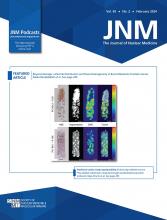TO THE EDITOR: In recent years, the management of patients with amyloid transthyretin–related (ATTR) cardiac amyloidosis (CA) has undergone major changes because of the validation of effective therapies. For example, new treatment with antibodies such as N1006 showed promise in depleting ATTR CA (1), and gene editing strategies showed promise in reducing levels of serum TTR protein in the hereditary forms of the disease (2).
In this context, tafamidis has secured an important role in the treatment of ATTR CA and has now been included in international guidelines (3), which underline the need for a timely start of therapy, as efficacy is reduced in more advanced stages of the disease (4). In this regard, it is undoubtedly clear that a prompt diagnosis is essential to yield favorable outcome in ATTR CA patients, and a reliable imaging modality able to provide an early and accurate diagnosis is essential.
Counterintuitively, guidance on where to direct our attention for early diagnosis of ATTR CA should be sought not in literature on the diagnostic accuracy of imaging modalities but in recent data on the use of these modalities for follow-up after tafamidis. In line with recent reports, a study recently published in The Journal of Nuclear Medicine (5) has shown that the degree of cardiac uptake in 99mTc-3,3-diphosphono-1,2 propanodicarboxylic acid (99mTc-DPD) SPECT decreases after therapy.
The most intriguing finding of this study was the somewhat unexpected decrease in 99mTc-DPD uptake. In fact, tafamidis essentially reduces deposition of amyloid fibrils within the myocardium rather than degrading them. Consistent with this concept, studies featuring cardiac MRI showed stabilization of extracellular volume after treatment (6). Hence, it is conceivable that a cardiac MRI–based calculation of extracellular volume reflects amyloid burden within the myocardium, whereas 99mTc-DPD SPECT reflects not the burden of amyloid but the degree of active deposition. This concept is consistent with the observation that 99mTc-DPD binds directly not to amyloid fibrils but to microcalcifications within amyloid (7). As happens with bone scans, only calcifications with active metabolism are expected to take up 99mTc-DPD, and the same concept pertains to amyloid imaging.
As such, if we aim to detect ATTR CA early, when the amyloid burden can be small but active deposition rapid, 99mTc-DPD may be preferred to yield an accurate diagnosis. In this regard, the most conceivable pattern of 99mTc-DPD uptake may not be diffuse and mild but rather moderate to intensive and localized in the left ventricular myocardial regions known to be affected first—that is, basal regions, with sparing of apical regions.
In this context, it is clear that planar 99mTc-DPD imaging should no longer be considered sufficient to make an early diagnosis. In fact, whereas small areas of mildly to moderately increased 99mTc-DPD uptake are likely to be missed on planar imaging, sensitivity is expected to be higher with SPECT. Furthermore, SPECT-based quantification of myocardial uptake may provide important information on the degree of active amyloid deposition at baseline and, thus, on prognosis (8). Although quantification of bone tracers with SPECT has shown little evidence of a prognostic role in later stages of the disease (9), the role may be more robust in earlier stages. This concept is also consistent with published recommendations (10), highlighting the importance of screening for ATTR CA in selected patients.
If future studies show 99mTc-DPD SPECT to have prognostic value in ATTR CA, this modality may become the gatekeeper to select patients more likely to benefit from tafamidis, thus optimizing allocation of resources in this increasingly prevalent disease. Hence, 99mTc-DPD SPECT may be the protagonist of this change in paradigm in the management of patients with ATTR CA. The nuclear medicine community should be ready to take up this challenge.
DISCLOSURE
Federico Caobelli is supported by a research grant by Siemens Healthineers and receives speaker honoraria from Bracco AG and Pfizer AG for matters not related to the present letter. No other potential conflict of interest relevant to this article was reported.
Federico Caobelli
University of Bern Bern, Switzerland
E-mail: federico.caobelli{at}insel.ch
Footnotes
Published online Jan. 11, 2024.
- © 2024 by the Society of Nuclear Medicine and Molecular Imaging.
REFERENCES
- Revision received September 20, 2023.
- Accepted for publication September 27, 2023.







